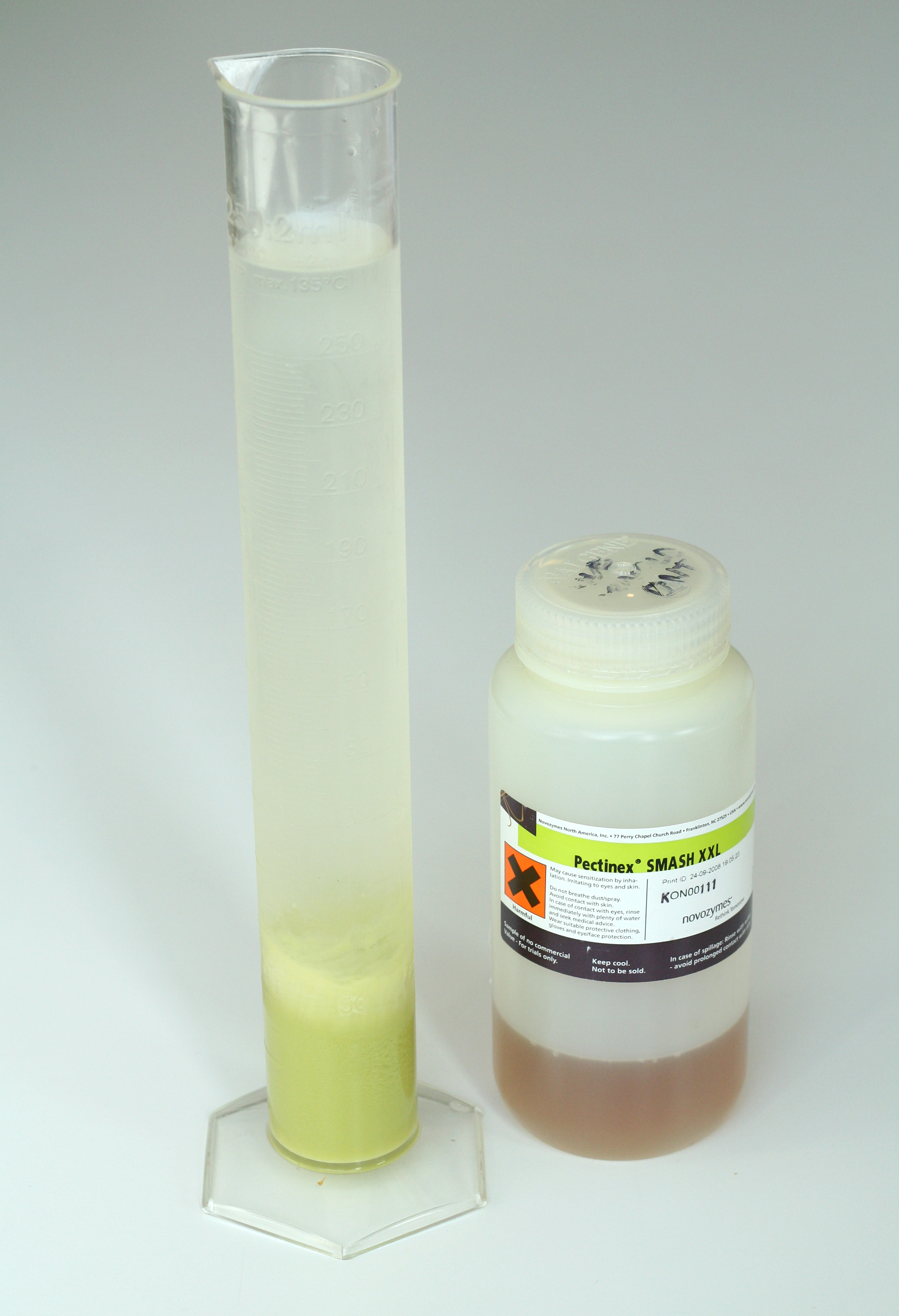Posted by Dave Arnold

Chadzilla had a good question about enzyme clarification: What is it? Many fruit juices, like apple and cucumber juice, are cloudy because of particles stabilized by pectin. You can use enzymes, like pectin lyase, to break down those pectins. We use a brand called Pectinex Smash by Novozymes. Simply add 1-2 grams of enzyme per liter of juice, stir, let sit overnight, and decant the clear liquid off the top. Don’t use a square container. Rotating a square container kicks up a lot of particles. The particles are so small they will go through a coffee filter, so be careful. We use the enzyme because it is convenient, easy, and gets a higher yield than gelatin or agar clarification. We especially like it with apples. A couple of chefs use it in their menus—my friend Johnny Iuzzini for one. As far as I know, Nils and Wylie were the first chefs to play with it years ago at an international food technology conference in Oklahoma. The only problem with the enzyme is it cannot tolerate extremely low pH, such as sour orange juice. By the way, when we get our centrifuge up, our clarification time with enzyme will go down to about 20 minutes and our yields will go up to something like 95%!

Have you guys tried vacuum filtration using a very fine membrane? Like 0.45 or 0.22 micron pore size?
We have done some work with vacuum filtration. Every time I have tried it the filters clog too easily. You then also have the problem of volatile aroma loss through the vacuum system (I would always end up boiling the liquid). We have also tried pressure filtration through a very fine-pore water filter (vacuum filtration only produces a 15 psi differential, with pressure we go up to 60 psi). The first couple hundred ml’s are good then…. clog. Wylie has tried beer and wine filters. I don’t think he has had luck. Angel Leon has his fired plankton filtration media. I have seen it demonstrated. It worked well on fish stock. I heard it didn’t work on juice. I also heard he has a new mix that does work on juice, but I haven’t seen or tried it.
works great on tomato. still tryin to figure out the time and temp to peel grapes
Howdy Asbel,
I was remiss in not mentioning you guys. Are you still using Pectinex? I tried the grape thing once but it didn’t eat the skin at all.
On the subject of Soda, I have been trying to figure out why a soda siphon should be used instead of a whip siphon.
I have been making a “cream” soda by adding an addition of apple pectin water to my juice or purees. This is for a cream effect and also lets me use a carbonated liquid that is stable and does not have to be served in a glass . I know this goes against this post as you are removing pectin and I am adding it! But for my method, I cannot find a difference in the results when I use the two different siphons. Any light on this?
I recently discovered your blog and am loving it!
Thanks for the insight.
Howdy,
We have done some work stabilizing bubbles with fluid gels, but not with pectin. The products really foam up but still hold their bubbles. The pectin in your product isn’t itself a nucleation site for bubbles (I think), but might slow bubble release. Unreleased bubbles encourage further CO2 loss (this is a guess). What has your experience been? What really helps about clarifying in terms of carbonation isn’t getting rid of the pectin, its getting rid of all the crud that is stabilized by the pectin.
As for soda siphon vs cream whipper, I always go cream. They are more versatile. I also don’t like having to dispense my product through the soda siphon tube/valve. It increases foaming and gas-loss on non-water products. I also like the wider mouth of the cream whipper. I don’t think I answered the question, did I?
Best,
Dave
hey Dave,
Ya the guys at Novozymes, said it was possible. haven’t followed up. i think it has to do with a combo of pectainese and another one along with vacuum, time and temp. as far as filtration have you used U.S. Standard Testing Sieve Drip Method? stack them and let it sit.
You have more patience than me brother! Seriously though, you make a good point. Hitting too fine a filter with too much crap often causes clogging. It is much better to use multiple filters that get progressively finer. We all instinctively know that it is sometimes best to go through a china cap before we go through a chinois, before we go through 4 layers of cheesecloth, before we go through a coffee filter. Perhaps we should do a post on filtration. There is filtration to remove odors (we make our “neutral grain spirits†much more neutral by charcoal filtering over and over and over). Plus, I have never used charged filtration media, which should be able to attract many of the things that make products cloudy. I had always assumed this was how Angel Leone’s filtration media works.
Glad Chad beat me to the question. I was also wondering about enzyme clarification.